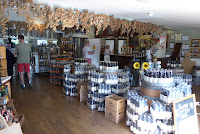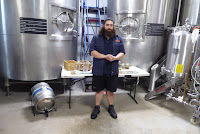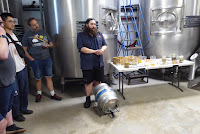Whenever you visit a micropub,
beer festival or a pub that has an extensive beer selection, often you will
find Porter on cask or in bottle. It is inconceivable to think that Porter was
once a beer style that was heading for extinction. Yet in 1973, this was the
case when Guinness announced that they would be ceasing production of Porter which
had been brewed at their Dublin brewery since 1778, due to a decline in sales
and demand. This marked the final nail in the coffin for the pint of plain (as
the Irish called it) which had been enjoyed by generations of dock workers and
other manual labourers over the past two centuries. Porter was seen as a
nourishing and rewarding drink after a hard days’ toil, as the journalist Larry
McCoubrey notes “if work was the curse of the working classes, then porter was
their salvation.”
Porter had been on a slow decline since the late 19th century, when
it was increasingly overtaken by the likes of Bitter and Pale Ale which were
becoming popular and breweries started to disregard Porter. As the writer
Martin Cornell points out, during this period Porters were also increasingly
sold as Mild and between 1860-1914, the gravity of porter dropped from 1.058 to
1.050 and the hopping rate from two to one pound per 36-gallon barrel. With the
onset of the First World War, and restrictions brought on by the higher taxes
on raw materials, this led to a devastating effect on Porter production which
fell to around 3% abv. After the war, Porter was increasingly overtaken by
Stout, and generally considered weak, thin and unpalatable, it was disregarded
as “a drink for old men”.
In 1938, the screenwriter T.E.B. Clarke described it as, “a lowly brand of
draught stout selling in the Public [bar] at fourpence a pint.” Two years later
on the 9th September 1940, Whitbread brewed their last batch of
Porter at their Chiswell Street brewery, the company along with the likes of
Barclay Perkins, Young’s, Truman’s and Meux’s had been the leading purveyors of
Porter production at it’s height in the century before, so it’s cessation of
Porter production marked an end of an era for a beer style that was established
and developed in London, which was instrumental in launching the mass
commercialisation of the brewing industry. All seemed lost, but as the real ale
boom gained traction in the 1970’s, enthusiasts and prospective brewers sought
to resurrect Porter and restore it back to it’s former glory, this is the of
story of the great Porter revival.
In 1972, Anchor Brewery launched
their Porter, which was the first warm fermented example of Porter in the
modern era. Developed by head brewer Fritz Maytag, who was seen as a visionary
and innovator, his successor Mark Carpenter notes “Fritz had remarkable
foresight, he saw what was coming when I swear no one else did.”
Des de Moor adds that a crucial feature of Maytag’s farsightedness “was his
recognition that resistance to the homogeneity of industrial brewing would
eventually express itself in the demand for variety of beer styles, each with
distinct flavours.” Brewed with a mixture of caramel, chocolate and black
malts, it was a dark ruby beer with a frothy ‘cappuccino’ coloured head and
creamy yet dry mouthfeel, it’s aroma of chocolate and expresso helped underly
its subtle sweetness. The release and success of this beer was crucial towards
inspiring others to develop their own Porters. A few years later in 1977, Martin
Griffiths set up Penhros Brewery on the site of derelict 13th century
manor house in Lyonshall, Herefordshire; along with Terry Jones (of Monty Python
fame) who was a real ale enthusiast and supported of CAMRA during its early
years. Following the release of their first beer Jones First Brew, in 1978 they
followed it with Penhros Porter which became the first ‘new’ Porter to be
commercially released in the UK since the cessation of Porter production a few
decades before. It rapidly gained a popular following around Herefordshire and
was widely sold around the county, until the Brewery closed in 1983. Later in
78’, two Yorkshire based brewers Timothy Taylor, and Samuel Smith’s released
their own respective Porters, the latter known as Taddy Porter has primarily
been sold in bottle form and is notable for being oldest Porter that is still commercially
sold in the UK.

As the Eighties dawned, word
about Porter’s revival spread and in 1981 a deluge of Breweries released their
own Porter, including the likes of Bragdy'r Defaid Du (Defaid Du), Portobello
(Bruce’s), Pirate’s Porter (Pier Hotel) Blackjack Porter (Ringwood) and Castle
Steamer (Three Tuns). In 1983, more releases came from Crouch Vale, Dempsey and
long-established breweries including Norfolk Porter (Woodfordes) and London
Porter (Young’s), Watney Mann released a Porter that utilized a recipe from the
defunct Hammerton Brewery. At a beer festival the same year, the newly established
Burton Bridge Brewery released a Porter as a one-off special at a beer
festival. It received a favourable response and it was subsequently released in
bottle and draught. Its development was the subject of extensive research by
the brewery’s then owners Bruce Wilkinson and Geoff Mumford, Des de Moor notes “interestingly,
the brewery’s Geoff Mumford says it wasn’t intended as a simple recreation, but
as a guess at how porter might have evolved if it had survived.”
Their Porter has since gone onto win festivals, including Silver at the National
CAMRA ‘Bottled Beer of the Year’ in 1987. The likes of Burton Bridge Porter led
the charge for the resurrection of Porter, during the latter years of the decade
a slew of other Breweries released Porters including Pimlico Porter (Orange), Porter
(Oak), Beardmore Porter (Strathalbyn), Porter (Larkins), Entire (Royal
Tunbridge Wells), Porter (Reepham) and Flag Porter (Pitfield). The later brew was
created by the Brewer’s Laboratory (Brewlab) after they successfully extracted
yeast from bottles of Porter found in a shipwreck that sunk near Littlehampton
in 1825. Using an 1850 recipe from Whitbread, and Chevalier Malt (which was commonly
used by breweries until 1920), they successfully managed to create a Brown Porter
that would have been drunk during early years the 19th century. Their
Porter was subsequently brewed by Elgood’s, and currently at Darwin’s.
The Nineties were a watershed
moment for the revival of Porter, as it cemented its reputation on the festival
circuit. At the Supreme Winter Beer of Britain awards at GBBFW 1991, Burton
Bridge won Silver in the Porter & Stout category. The following year saw
Bateman’s Salem Porter and Malton Pickwick Porter win Gold and Silver within
the same category, whilst later that summer at the Supreme Beer of Britain awards
at GBBF, Bateman’s won Bronze. 1992, also saw Exmoor Brewery launch their
Exmoor Beast Porter, at a hefty 6.6% (brewed from a combination crystal, pale
and chocolate malts with a combination of Challenger, First Gold and Goldings
hops) it is rather strong for a Porter. Described as having an old fashioned strength
since most Porters during the early 19th century was brewed to a
similar level, Adrian Tierney Jones broadly describes “it was rich and
luscious, dark and roasty, bittersweet, complex and comfortable in the way it
pleased my palate.”
The palatable beverage with its complex flavours of coffee, dried fruits and
rum, has since become widely sold, and has won numerous awards including Gold –
Tesco’s Best Autumn Beer 2002, Overall Cask Champion – SIBA 2017 and more
recently Silver – GBBFW 2023 (Strong Ales category). At GBBFW 1993, Coach House
Brewery won Gold in the Porter & Stout category for their Blunderbus
Porter, an incredible feat given that the Brewery had only been in operation
for two years. In February 1993, Elgood's released Sir Henry's Porter which was developed by (then newly appointed) head brewer Alan Pateman as a one off brew to mark the retirement of his predecessor Sir Henry Holder, it proved popular enough to become a seasonal beer and it was subsequently renamed North Brink Porter, which is also used in their Plum and Blackberry Porters respectively. The following year at GBBFW 1994, saw Porter dominate all three top award
places in the Porter & Stout category, with Elgood’s North Brink Porter
(Bronze), Hambleton Nightmare Porter (Silver) and Coach House Blunderbus Porter
(Gold), the latter achieving that feat for a second year in a row, they also
one Silver for this beer at the Supreme Beer of Britain awards at GBBF later
that year. In 1995, the likes of Harvey’s Porter and RCH Old Slug Porter win Gold
and Silver respectively. Harvey’s Porter was based on an 1859 recipe, which was
revived when the brewery resurrected the Porter in the early Nineties, and has
since become one of the most prolific award winners in the UK and
internationally. Continuing the revival of old beers, in 1996, Fuller’s released
their London Porter; it was based on a 19th century recipe that was discovered
by then head brewer Reg Drury. With it’s blend of Brown, Crystal and
Chocolate malts, it had echoes of the great Victorian Porters, imbued with an earthy
aroma and a creamy mouthfeel that has hints of chocolate and coffee flavours.
The beer subsequently has won various accolades including Gold - International
Beer & Cider Challenge (1999), Silver - Supreme Beer of Britain Awards
(GBBFW 2007), Gold - Stout & Porter (GBBF 2007) and Silver - World Beer
Awards (Porter & Stout 2011) respectively, and is still sold commercially.
After a two year absence, GBBFW returned in 1997 with Hambleton’s Nightmare
Porter (Gold) and Wickwar Station Porter (Silver) in the Stout & Porter category.
Interestingly, Nightmare Porter which was developed by then head brewer Nick
Stafford in 1993 was accidentally developed, Stafford states "I had a recipe but
not all the ingredients. It was a crazy disastrous moment. I just didn't have
everything and it was early in the morning, so we cobbled together something and it turned out alright."
This accidental beer has since become one of the brewery’s flagship products and
has won them numerous awards at GBBFW and the SIBA (North) Festival respectively.
1998, saw Porter dominate the top three places in the Porter & Stout category
at GBBFW for the second time that decade with McGuiness Tommy Todd’s Porter
(Bronze), Wickwar Station (Silver) and Shepherd Neame Original Porter along
with Nethergate Old Growler (joint, Gold). Old Growler won Gold again at GBBFW
in 2003, and in the US, it has won awards including Supreme Champion – Chicago
International 2011 and Best of 2011 by the Beer Tasting Institute of America,
this multi-award winning brew continues to be sold commercially to this day.

Since the beginning of the 21st
century, Porter has had less yearly dominance in the Supreme Winter Beer of
Britain category at GBBFW, although in 2008 a separate category for Porter was
created that finally gave yearly recognition for Porters released by various
breweries. One of the notable examples from this category was Elland’s 1872
Porter, which has frequently won awards including Gold on five occasions and Silver
twice. Based on a 19th century recipe revived by brewer Michael
Wynnyczuk, this rich, complex and robust beer has subsequently won three Gold
awards in the Supreme category at GBBFW, Gold at SIBA (North East) – Premium
Strong Beers and in 2013 it won the ultimate accolade when it was awarded Gold
at the Champion Beer of Britain (overall) category at GBBF, which marked the very first time a
Porter had won this prestigious award. A decade later, it won the same award for the second time at GBBF earlier this month. The success of Elland’s 1872 Porter, is
demonstrative of the remarkable revival of Porter as a beer style. Nowadays,
numerous breweries across the country now include Porter in their ranges, and
it can be readily found in shops, beer festivals and pubs with a large range of
real ales. Craft Beer & Brewing note “given that porter beer has seen so
many changes over its nearly 3 centuries of existence, it is perhaps not
surprising to see that it has arrived into the 21st century newly refreshed and
ready for another star turn.”

References















